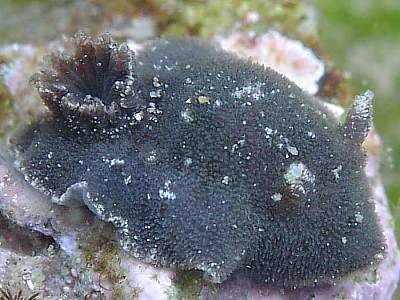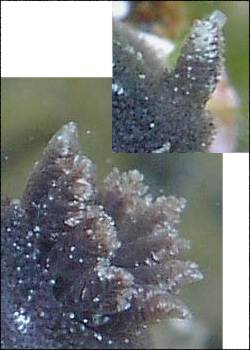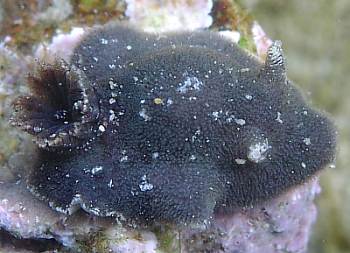

Rostanga risbeci
Baba, 1991
Order: NUDIBRANCHIA
Suborder: DORIDINA
Superfamily: EUDORIDOIDEA
Family: Dorididae
PHOTO
Shimoda, Izu Peninsula, Sagami Bay, Japan, 0.3m (Intertidal). Size: about 12mm, 13 Jan 2002. Photos: Jun Imamoto
Until quite recently it was considered there was a single species of Rostanga in Japan which ranged in colour from orange red to black. Following Rudman & Avern's (1989) review of the genus, Baba (1991) showed that there are at least two species in Japan, and he named the black form as a distinct species, R. risbeci, after Jean Risbec who described a black Rostanga from New Caledonia many years ago.
The main external features of Rostanga risbeci are that it is black, or grayish black with scattered opaque white specks or patches. The rhinophores are white-tipped and the gills are speckled with white. All but the innermost radular teeth are long with a bifid tip, very similar to R. dentacus Rudman & Avern, 1989, which differs in being orange red in colour. R. risbeci is reported by Dr Baba to feed on the black sponge Halichondria okadai (Kadota, 1922).
References:
• Rudman, W.B., Avern, G. (1989) The genus Rostanga (Nudibranchia: Dorididae) in the Indo-West Pacific. Zoological Journal of the Linnean Society, 96(3): 281-338.
• Baba, K. (1991) Review of the genus Rostanga of Japan with the description of a new species (Nudibranchia: Dorididae). Venus, The Japanese Journal of Malacology 50(1): 43-54. (Figs 1-5, Pl.1)
Rudman, W.B., 2002 (January 16) Rostanga risbeci Baba, 1991. [In] Sea Slug Forum. Australian Museum, Sydney. Available from http://www.seaslugforum.net/find/rostrisb
Related messages
Rostanga risbeci and R. atrata
January 28, 2002
From: Nishina Masayoshi
Dear Bill, "Here the black Rostanga of Japan is named as R. risbeci n. sp. after Dr Jean Risbec who worked on a black Rostanga of New Caledonia. Possibly Rostanga risbeci n. sp. from Japan is conspecific with the black R. atrata: Risbec, 1953, in the black body color, white spawn, and buccal morphology (jaw and radula). " Does this mean that Baba suspected that Rostanga risbeci was a synonym of Rostanga atrata? • Baba, K. 1991 Review of the Genus Rostanga of Japan with the description of a new species., The Venus, 50 (1): 43-54. Best Regards, nishina@wips.co.jp Dear Nishina, It is difficult to identify Risbec's species with any described species but it could be Rostanga risbeci As Risbec's name Rostanga atrata is simply a misidentification it has no taxonomic status. Until further material is available from New Caledonia the identity of Risbec's species will be a mystery. Dr Baba wrote to me about his black Rostanga when he was preparing his paper. My feeling was that the shape of the radular teeth suggested it might be a black colour form of Rostanga dentacus, but we will need to examine more specimens and look at their natural history - egg ribbons, food sponges etc., before we can be sure one way or the other. I am at the moment preparing some "Fact Sheets" on all the species of Rostanga. One problem with studying them is that they are difficult to identify alive because they are so similar in shape and colour. That is why I keep asking for information on egg ribbons and food sponges because we do know that these can be very useful identification tools. • Rudman, W.B., Avern, G. (1989) The genus Rostanga (Nudibranchia: Dorididae) in the Indo-West Pacific. Zoological Journal of the Linnean Society, 96(3): 281-338. Best wishes, Dear Bill. Best Regards, imamoto@wips.co.jp Dear Bill. I had advice that it looked like Rostanga risbeci from Mr. Hideyuki Takasu (Nudibranchs of Hachijo Island). Is it the same as the Rostanga risbeci which you commented on to Ms. Rie Nakano? [Photograph data] Best Regards, imamoto@wips.co.jp
Dear Jun,
I had the opportunity to exchange ideas about Rostanga risbeci with Haruo Kinoshita. He told me that Baba described in his description
Nishina Masayoshi
Risbec (1953) described a black dorid from New Caledonia which in all aspects of its external and internal anatomy would appear to be a species of Rostanga. He identified it with Doris atrata Kelaart and named it Rostanga atrata Kelaart. However as I have discussed previously (Rudman & Avern, 1989) Kelaart's species was not a species of Rostanga. Kelaart's species from Ceylon [Sri Lanka] was described as pure black with white tips to the rhinophores. No illustrations were published but Eliot (1906b, c) in his report on a re-examination of Kelaart's specimens and illustrations considers it to be synonymous with Dendrodoris nigra Stimpson.
Bill Rudman
Re: Rostanga risbeci? from Japan.
January 19, 2002
From: Jun Imamoto
Thanks for your comments. I now understand the importance of observing the environment in which these animals live. Next time, we go to Shimoda, it will be observed carefully.
Thank you very much.
Jun Imamoto
Rostanga risbeci? from Japan.
January 18, 2002
From: Jun Imamoto

I took these pictures of a sea slug which looks like Rostanga in a tide pool. Most Rostanga species which I know of are mainly orange. Therefore, I haven't been able to identify this sea slug.
Date: 13 Jan 2002
Place: Shimoda, Izu Peninsula, Sagami Bay, Japan
Depth: 0.3m (Intertidal)
Size: about 12mm
Water temperature: 15C degrees.
Jun Imamoto

It is difficult to be sure externally between species of Rostanga and Jorunna, but the shape of the gills - short and numerous, make me pretty certain that this is a species of Rostanga. And from its colour I would say that it fits Dr Baba's description of Rostanga risbeci very well. Dr Baba said it had been found feeding on a black sponge so perhaps next time you are at Shimoda could could see if you can find a black sponge. If you are lucky you might find an animal laying its egg ribbon on the sponge because in my experience species of Rostanga almost always lay their egg ribbons either on their food sponge or very close by.
Best wishes,
Bill Rudman
